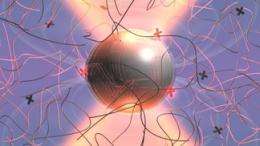Eddies in Einstein's formula

(�鶹��ԺOrg.com) -- How does a microscopic particle behave in a liquid? New results published in the journal Nature show that Einstein’s formula for describing this situation needs a little adjustment. This will in turn open up possibilities for new applications, particularly in biology.
A pollen grain suspended in water appears to move about randomly; this is what is known as “Brownian Motion.” The grain is hit on all sides by water molecules, which make it quiver. At the human scale, on the contrary, a swimmer plows forward in the water by continuing to move in the direction of her propulsion; her motion is aided by the eddies that she leaves in her wake. For the first time, physicists have observed and measured the effect of these eddies at the microscopic scale. They have found that the viscosity of the water doesn’t completely inhibit the momentum that the water molecules transfer to the pollen grain. As Einstein suspected back in 1905, his formula describing Brownian motion needs to be adjusted.
By observing at very high speeds the shadow cast by a the particle on a detector, researchers in EPFL’s Laboratory of Complex Matter �鶹��Ժics were able to show, and measure, the existence of eddies formed by a particle in motion in a liquid. These tiny vortices dissipate after just five microseconds. “The rate at which the vortex dissipates depends on the size of the particle that creates it and the density and viscosity of the liquid,” explains Sylvia Jeney.
Optical tweezers
The challenge was to measure the characteristics of these vortices. To do this, the physicists used what they refer to as “optical tweezers.” Using a laser, they are able to hold very small objects, such as a particle in a liquid, as if the particle was attached to the end of a spring. By measuring the vibration of the particle against the spring, they can demonstrate that the vortex increases the particle’s fluctuations. And, inversely, it is possible to determine certain properties of the particle, such as its size or shape, from the characteristics of the vortex. It’s as if one could deduce the size or shape of a swimmer’s body from the wake she leaves in the water.
From biology to sensors
These developments hold promise for making improvements in many areas. “In biology, exchanges between the cell and its surroundings take place in a liquid medium; proteins or viruses that pass through the membrane are one example,” notes Jeney. Elsewhere, micro-sensors used in viscous media currently lack precision. They are used to test interactions in a liquid between a drug and various molecules attached to a microscaffolding. These results could help scientists improve these interactions.
More information: Resonances arising from hydrodynamic memory in Brownian motion, Thomas Franosch, et al., Nature, 05.10.2011,
Direct observation of the full transition from ballistic to diffusive Brownian motion in a liquid, Rongxin Huang, et al., Nature�鶹��Ժics, 27.03.2011,
Provided by Ecole Polytechnique Federale de Lausanne




















